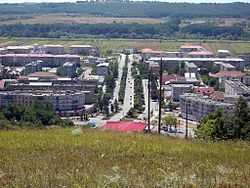Motru
| Motru | |
|---|---|
| Municipality | |
|
View over the city from Motru Hills | |
 Motru Location of Motru | |
| Coordinates: 44°48′13″N 22°58′15″E / 44.80361°N 22.97083°ECoordinates: 44°48′13″N 22°58′15″E / 44.80361°N 22.97083°E | |
| Country |
|
| County | Gorj County |
| Status | Municipality |
| Government | |
| • Mayor | Dorin Hanu (Social Democratic Party) |
| Area | |
| • Total | 50.09 km2 (19.34 sq mi) |
| Population (2002) | |
| • Total | 22,848 |
| Time zone | EET (UTC+2) |
| • Summer (DST) | EEST (UTC+3) |
| Postal code | 215200 |
| Website | http://www.primaruleunbou.ro/ |
Motru (Romanian pronunciation: [ˈmotru]) is a city in Romania, Gorj County.
Motru is situated on the river of the same in western Oltenia. The county capital Târgu Jiu is located about 35 km northeast. The city administers eight villages: Dealu Pomilor, Horăști, Însurăței, Leurda, Lupoița, Ploștina, Roșiuța and Râpa.
History
| Historical population | ||
|---|---|---|
| Year | Pop. | ±% |
| 1977 | 15,998 | — |
| 1992 | 26,626 | +66.4% |
| 2002 | 25,860 | −2.9% |
| 2011 | 18,142 | −29.8% |
| Source: Census data | ||
Motru was created by an administrative decision in 1966 on the territory of the former Ploștina commune, which, together with seven other villages, became part of the new city. The reason behind the decision to create a city was the development of several coal deposits.
The region is at least since the time of the Roman Empire, inhabited, in the district Leurda in 1964 found some silver coins from the time of Emperor Septimius Severus (193-211). The oldest documented settlement in the territory of present-day town Ploština (1385 is mentioned).
The Dacian town Amutria is mentioned in ancient sources like Ptolemy's Geographia (c. 150 AD) and Tabula Peutingeriana (2nd century AD), and potentially placed here.[1] The name is homonymous with the ancient name of Motru river.[1] After the Roman conquest of Dacia, Amutria was part of an important road network, between Drubetis and Pelendava.
Present
In today's incorporated villages were partially free farmers, others were in the monastery Tismana submissive.
2000 Motru the municipality (Municipul) - i.e. a greater city - nominated .
The main city is the mining industry, while also playing - especially in the incorporated villages - Agriculture and livestock play an important role. Population
In the 2011 census in the city were 18,142 people, including 17,988 Romanians, 38 Hungarians, 83 Roma and 3 Germans.
Transportation
Motru has a rail connection on a route leading from Strehaia, which was put into operation in 1962. Several times a day commuter trains travel to Craiova. In addition, there are bus connections in the district capital of Targu Jiu. Motru is on the National Road 67 from Drobeta Turnu Severin to Ramnicu Valcea.
See also
Notes
- ↑ 1.0 1.1 Schütte 1917, p. 96.
References
| Wikimedia Commons has media related to Motru. |
- Schütte, Gudmund (1917). Ptolemy's maps of northern Europe: a reconstruction of the prototypes. Copenhagen: H. Hagerup.
